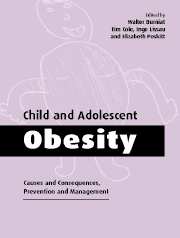Book contents
- Frontmatter
- Contents
- List of contributors
- Foreword
- Preface
- Part I Causes
- 1 Measurement and definition
- 2 Epidemiology
- 3 Molecular and biological factors with emphasis on adipose tissue development
- 4 Nutrition
- 5 Physical Activity
- 6 Psychosocial factors
- Part II Consequences
- Part III Prevention and management
- Index
3 - Molecular and biological factors with emphasis on adipose tissue development
Published online by Cambridge University Press: 02 November 2009
- Frontmatter
- Contents
- List of contributors
- Foreword
- Preface
- Part I Causes
- 1 Measurement and definition
- 2 Epidemiology
- 3 Molecular and biological factors with emphasis on adipose tissue development
- 4 Nutrition
- 5 Physical Activity
- 6 Psychosocial factors
- Part II Consequences
- Part III Prevention and management
- Index
Summary
Introduction
The energy content of the human body is under the control of several regulatory systems (Rosenbaum & Leibel, 1998). Changes in body energy content and changes in the size of adipose tissue – the major energy store of the body – result from alterations in the balance between energy intake and energy expenditure. The various regulatory systems produce different signals of which the main messages are integrated in the hypothalamus, where appetite and satiety, as well as the sympathetic and parasympathetic nervous systems, the hypothalamo-hypophysio-thyroid axis, and other endocrine systems are controlled.
Recent scientific data have clearly discarded the once widespread idea that obesity, which is an increase in body energy stores, just reflects a lack of willpower. It is evident that obesity results from changes in the above-mentioned regulatory systems with a lack of adequate counter-regulation, thus leading to positive energy balance. Recently, a few monogenetic defects, which occur rarely, have been shown to be associated with severe and early-onset obesity in humans. However, it is evident that the development of obesity, in the vast majority of cases, is a multifactorial event with a genetic predisposition affected by environmental factors which, so far, are not fully understood.
The storage of energy in white adipose tissue is physiologically important for survival during times of starvation, for fertility, for adequate function of the immune system and thus for overall well-being and health.
- Type
- Chapter
- Information
- Child and Adolescent ObesityCauses and Consequences, Prevention and Management, pp. 50 - 68Publisher: Cambridge University PressPrint publication year: 2002
- 2
- Cited by



